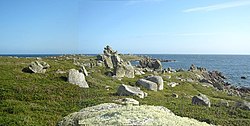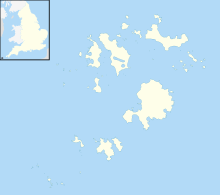Wingletang Down
| Site of Special Scientific Interest | |

Wingletang Down, looking south
|
|
| Grid reference | SV883076 |
|---|---|
| Coordinates | 49°53′17″N 6°20′28″W / 49.888°N 6.341°WCoordinates: 49°53′17″N 6°20′28″W / 49.888°N 6.341°W |
| Interest | Biological |
| Area | 28.9 hectares (0.2890 km2; 0.1116 sq mi) |
| Notification | 1971 |
| Natural England website | |
Wingletang Down is a Site of Special Scientific Interest (SSSI) on the southern side of the island of St Agnes in the Isles of Scilly, England, UK, which is noted for its biological characteristics. The site is managed by the Isles of Scilly Wildlife Trust and is within the Isles of Scilly Heritage Coast and the Isles of Scilly Area of Outstanding Natural Beauty. It is the only site in Great Britain and Ireland for the small fern, least adder’s–tongue (Ophioglossum lusitanicum). As of 11 September 2009 the SSSI was considered to be in ″unconditional recovering″ condition because European gorse (Ulex europaeus) and bramble (Rubus fruticosus) are at unacceptable levels.
Forty–three Bronze Age cairns have been recorded, some of which have granite kerbstones and others are linked by hedge walls. A cairn usually indicates a burial site.
On the west side of St Warna’s Cove is a stone–lined well that is reputed to be of great antiquity, and close to where the saint is supposed to have come ashore in a coracle after a journey from Ireland. The name Warna is unknown anywhere else as a Celtic saint, and may be the name of a Celtic water goddess. In the past pins were dropped into the well as an offering to encourage storms to drive ships ashore. Wrecks were a vital resource for coastal communities. Ceramic beads from the 17th-century wreck of a Venetian ship can be found on the beach at Beady Pool on Wingletang Bay.
The underlying rock is Hercynian granite covered by thin, skeletal and podzolic soils on the higher land where there are many weathered outcrops. At the southernmost tip is Horse Point which is almost separated from the rest of St Agnes by a narrow neck of blown sand between two bays; Wingletang Bay and Porth Askin. Along the coast to the west towards St Warna Cove are boulder beaches.
...
Wikipedia

